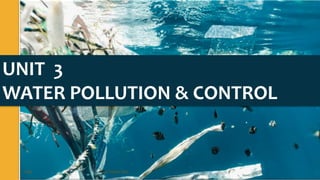
Unit 3 water_pollution_samak_alam[1]
- 1. Date Your Footer Here 1 UNIT 3 WATER POLLUTION & CONTROL
- 2. CONTENTS 2 Introduction Definition of water pollution Causes of water pollution Effects of water pollution Measures of water pollution Reference
- 3. Water Pollution In Aquatic
- 4. INTRODUCTION Water is a precious resource and without it life is not possible on earth. Water is getting polluted day by day due to excessive and careless use so the percent of available drinking water is reducing. There are many ways which causes water pollution and the effects of it are very harmful for all living and non living objects. Date Your Footer Here 4
- 5. CAUSES OF WATER POLLUTION The Principal sources of water pollution resulting from exploration and production operations are:- 1. Domestic waste 2. Sewage System 3. Solid Waste 4. Industrial Waste 5. Acid Rain 6. Oil Industry 5
- 6. Date Your Footer Here 6 1. Domestic Waste . Domestic waste is waste that is generated as a result of the ordinary day-to-day use of a domestic premise and is either: ... collected or on behalf of a local government as part of a waste collection and disposal system.
- 8. 2. Sewage waste Sewage is made up of the wastewater from residences and institutions, carrying bodily wastes washing water, food preparation wastes, laundry wastes, and other waste products of normal living. This is classified as sewage or domestic wastewater.
- 9. Here goes the subtitle of your section Date Your Footer Here 9 3. Solid waste Solid waste causes blockage in flow of water. It causes water as well as air pollution. Polythene is the main solid waste. One of the most dangerous water pollution.
- 10. 4. Industrial Waste Industrial waste is defined as waste generated by manufacturing or industrial processes. The types of industrial waste generated include cafeteria garbage, scrap metals, trash, oil, solvents, chemicals, weed and similar wastes.
- 11. 5. Acid Rain Acid rain makes such waters more acidic, which results in more aluminum absorption from soil, which is carried into lakes and streams. That combination makes waters toxic to crayfish, clams, fish, and other aquatic animals.
- 12. 6. Oil Industry Oceans are polluted by oil on a daily basis from oil spills, routine shipping, run-offs and dumping. Oil spills make up about 12% of the oil that enters the ocean.
- 14. Harmful Effects of Water Pollution:- Destruction of biodiversity. Water pollution depletes aquatic ecosystems and triggers unbridled proliferation of phytoplankton in lakes Contamination of the food chain. Fishing in polluted waters and the use of waste water for livestock farming and agriculture can introduce toxins into foods which are harmful to our health when eaten. Lack of potable water. The UN says that billions of people around the world have no access to clean water to drink or sanitation, particularly in rural areas. Date Your Footer Here 14
- 15. Lack of potable water. The UN says that billions of people around the world have no access to clean water to drink or sanitation, particularly in rural areas. Disease. The WHO estimates that about 2 billion people have no option but to drink water contaminated by excrement, exposing them to diseases such as cholera, hepatitis A and dysentery. Infant mortality. According to the UN, diarrhoeal diseases linked to lack of hygiene cause the death of about 1,000 children a day worldwide. 15
- 17. HOW CAN WE CONTROL WATER POLLUTION 1. Use Less Plastic It is very difficult to break down plastic after it is produced. Much of the plastic we consume ends up in the world’s water supply, where it is even harder to fish out and safely throw away. 2. Reuse Items Whenever you buy something that is not recyclable, such as plastic, it is better to reuse this item as many times as possible. This habit limits your consumption and means less of those products will end up in the world’s rivers, lakes, and oceans. 3. Recyclable Options If there are two options for a particular item, try to pick the one that is easily recyclable. Glass bottles are much better for the environment than plastic, for example. Date Your Footer Here 17
- 18. 4. Cleaning Chemicals Similar to oils, cleaning chemicals are hazardous when they enter the water supply. If you are emptying containers of household cleaning supplies, do it in the trash can, not in the sink. 5. Handle Toxic Chemicals Properly The toxic chemicals like ammonia, bleach, paint, paint thinner, and many other chemicals are becoming a severe problem, and if these are dumped down the drain or the toilet, the effects add up. Therefore proper disposal of these is important 6. Avoid Toilets For Throwing Household Items Toilet paper is specifically made in a way that breaks down easily in water pipes, but the fiber-reinforced cleaning products that pollute the system.
Notas del editor
- © Copyright PresentationGO.com – The free PowerPoint and Google Slides template library
- © Copyright PresentationGO.com – The free PowerPoint and Google Slides template library